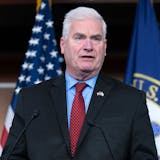Every morning, wildland firefighters gather around radios to listen to the weather forecast. This summer, I was part of the team that fought a fire near Big Sur. When I heard the staticky voice announce that temperatures would exceed 105 degrees, the forecast sounded like a death sentence.
Across California, unprecedented heat has made wildfires more difficult to predict and control. During the heat wave in Big Sur, the fire, which had been 40% contained at 30,000 acres, tripled in size in a matter of days. It has now burned nearly 125,000 acres.
Fighting wildfire involves hauling heavy packs and tools up mountains. Record heat makes this work more difficult and dangerous. After hours cutting atop an exposed ridge, my arms and legs spasmed from muscle cramps. Extreme heat makes hearts race and brains falter. Firefighters often collapse. In Big Sur, plumes of smoke grew like thunderclouds.
We have entered the age of megafires. Since 1970, yearly fire seasons in California have grown by 78 days. The amount of land burned annually across the Western U.S. has doubled since 1980. Earlier this month, the August Complex fire in Northern California set a record for the state, burning more than 1 million acres. That record will probably not stand for long.
These extreme fires are caused by two main factors: fire suppression and climate change. The dangerous consequences of fire suppression are now widely acknowledged. But the role of climate change on wildfires — more heat, less rainfall and lower humidity in fire-prone regions — is either being minimized or pushed from the frame.
In Big Sur, when the sun melted into the Pacific and we returned to base camp, I sat by the internet hot spot to text my mom and touch base with the world. I was not surprised to see President Donald Trump denying the existence of climate change during his visit to California in September. I was more concerned by the new form of attack on climate science being pushed by popular right-wing commentators like Ben Shapiro.
Faced with irrefutable evidence, this stance acknowledges that climate change exists, but denies how much scientists know, how much climate change currently matters and how possible it is to cut carbon emissions. This position may sound nuanced and pragmatic, but it is just as false and damaging to science-backed decarbonization efforts as outright denialism. In fact, it may be more dangerous because it sounds less extreme.
As a researcher of climate change and land management, I know that just several generations of fossil fuel emissions have produced higher atmospheric carbon concentrations than have existed at any point in human history. Scientists are certain that the majority of current climatic extremes are the result of this rapid carbon influx.



